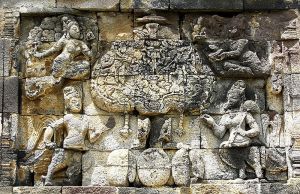The Wishing Tree
A Hindu parable
One way of gaining insight into the doctrine of karma is through the parable of the Kalpataru, or the Wishing Tree:
 Into a room full of children at play walks their uncle, who, of course, knows better. Laughing at their preoccupation with make-believe games, he asks them to go out to the massive banyan tree, which will grant them whatever they wish! The children rush out, stand under the branches of this huge tree that cover the sky, and ask for what all children crave: toys and candy. In a flash they get what they want, but along with an unexpected bonus: the built-in opposite of what they wished for. With toys they get boredom; with candy, tummy aches.
Into a room full of children at play walks their uncle, who, of course, knows better. Laughing at their preoccupation with make-believe games, he asks them to go out to the massive banyan tree, which will grant them whatever they wish! The children rush out, stand under the branches of this huge tree that cover the sky, and ask for what all children crave: toys and candy. In a flash they get what they want, but along with an unexpected bonus: the built-in opposite of what they wished for. With toys they get boredom; with candy, tummy aches.
Sure that something has gone wrong with their wishing, the children ask for bigger toys and sweeter candy. The tree grants them their wishes, and along with them bigger boredom and bigger tummy aches. Time passes. They are now young men and women and their wishes change, for they know more. They ask for wealth, power, fame, sexual pleasure–and they get these, but also cupidity, insomnia, anxiety, and frustration/disease.
Time passes. The wishers are now old and gather in three groups under the all-encompassing branches. The first group exclaims, “All this is an illusion!” Fools, they have learned nothing. The second group says, “We are wiser and will wish better wishes next time.” Greater fools, they have learned less than nothing. The third group, disgusted with everything, decides to cop out and asks for death. They are the most foolish of all.
All this while one child has been unable to move out of the room. Being lame, he was pushed down in the scramble and when he dragged himself to the window, he was transfixed watching his friends make their wishes, get them with their built-in opposites and suffer, yet compulsively continue to make more wishes. Riveted by this utterly engrossing display of desire and its fruits, a profound swell of compassion welled up in the heart of this lame child, reaching out to his companions. And in one dazzling, illuminating spectacle he saw this whole thing and stood there, marveling at the spectacle of the universe—these are the words now, very carefully used when the story is told again and again by village storytellers, by mothers, by others, whoever tells it, “marveling at the spectacle of the universe”—at the cosmic swindle of life, at the divine comedy (well, tragicomedy). There was a gush of compassion in his heart for his companions under the tree. And in that gush of compassion, he forgot to wish. He forgot to wish and the tree couldn’t touch him. He was free. He is the liberated one, for the tree has no power over him.
BYU Religious Studies Center, Literature of Belief: Sacred Scripture and Religious Experience: The Hindu Experience: An Examination of Folklore and Sacred Texts – http://bit.ly/yd7Oi9
(See also: Purushottam Lal in chapter 5: Literature of Belief: Sacred Scripture and Religious Experience, p. 92-107.)
